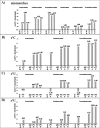A systematic study on the influence of thermodynamic asymmetry of 5'-ends of siRNA duplexes in relation to their silencing potency
- PMID: 30792489
- PMCID: PMC6385221
- DOI: 10.1038/s41598-018-36620-9
A systematic study on the influence of thermodynamic asymmetry of 5'-ends of siRNA duplexes in relation to their silencing potency
Abstract
siRNA molecules possess high potential as molecular tools and can be used as effective therapeutics in humans. One of the key steps in the action of these molecules is the choice of antisense strand by the RNA-induced silencing complex (RISC). To explain this process, we verified the theory which states that antisense strand selection is based on the thermodynamically less stable 5' end of siRNA. Based on the studies presented herein, we observed that for the tested siRNA duplexes, the difference in the thermodynamic stability of the terminal, penultimate and pre-penultimate pairs in the duplex siRNA is not the dominant factor in antisense strand selection. We found that both strands in each tested siRNA molecule are used as an antisense strand. The introduction of modified nucleotides, whose impact on the thermodynamic stability of siRNA duplexes was studied, results in changes in antisense strand selection by the RISC complex. The presence of a modified residue often caused predominant selection of only one antisense strand which is at variance with the theory of siRNA strand bias.
Conflict of interest statement
The authors declare no competing interests.
Figures








Similar articles
-
Crystal structure, stability and in vitro RNAi activity of oligoribonucleotides containing the ribo-difluorotoluyl nucleotide: insights into substrate requirements by the human RISC Ago2 enzyme.Nucleic Acids Res. 2007;35(19):6424-38. doi: 10.1093/nar/gkm664. Epub 2007 Sep 18. Nucleic Acids Res. 2007. PMID: 17881374 Free PMC article.
-
Exploring 5'-Biotinylation of the Sense Strand to Improve siRNA Specificity and Potency.Methods Mol Biol. 2020;2115:163-170. doi: 10.1007/978-1-0716-0290-4_9. Methods Mol Biol. 2020. PMID: 32006400
-
Asymmetry in the assembly of the RNAi enzyme complex.Cell. 2003 Oct 17;115(2):199-208. doi: 10.1016/s0092-8674(03)00759-1. Cell. 2003. PMID: 14567917
-
[Components and assembly of RNA-induced silencing complex].Yi Chuan. 2006 Jun;28(6):761-6. Yi Chuan. 2006. PMID: 16818443 Review. Chinese.
-
Advances in structural-guided modifications of siRNA.Bioorg Med Chem. 2024 Aug 1;110:117825. doi: 10.1016/j.bmc.2024.117825. Epub 2024 Jun 28. Bioorg Med Chem. 2024. PMID: 38954918 Review.
Cited by
-
Transcriptome-wide analysis reveals insight into tumor suppressor functions of 1B3, a novel synthetic miR-193a-3p mimic.Mol Ther Nucleic Acids. 2021 Jan 26;23:1161-1171. doi: 10.1016/j.omtn.2021.01.020. eCollection 2021 Mar 5. Mol Ther Nucleic Acids. 2021. PMID: 33664995 Free PMC article.
-
Terminal bridging of siRNA duplex at the ribose 2' position controls strand bias and target sequence preference.Mol Ther Nucleic Acids. 2023 Apr 19;32:468-477. doi: 10.1016/j.omtn.2023.04.013. eCollection 2023 Jun 13. Mol Ther Nucleic Acids. 2023. PMID: 37168798 Free PMC article.
-
An Influence of Modification with Phosphoryl Guanidine Combined with a 2'-O-Methyl or 2'-Fluoro Group on the Small-Interfering-RNA Effect.Int J Mol Sci. 2021 Sep 10;22(18):9784. doi: 10.3390/ijms22189784. Int J Mol Sci. 2021. PMID: 34575949 Free PMC article.
-
MSC-derived exosomes carrying a cocktail of exogenous interfering RNAs an unprecedented therapy in era of COVID-19 outbreak.J Transl Med. 2021 Apr 22;19(1):164. doi: 10.1186/s12967-021-02840-3. J Transl Med. 2021. PMID: 33888147 Free PMC article. Review.
-
Specificity of oligonucleotide gene therapy (OGT) agents.Theranostics. 2022 Oct 9;12(16):7132-7157. doi: 10.7150/thno.77830. eCollection 2022. Theranostics. 2022. PMID: 36276652 Free PMC article. Review.
References
Publication types
MeSH terms
Substances
LinkOut - more resources
Full Text Sources

